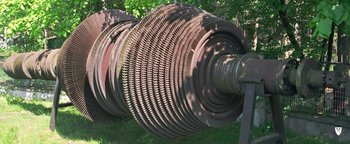Steam turbine
|
|
A steam turbine extracts the energy of pressurized superheated steam as mechanical movement.
In a Parsons-Westinghouse steam turbine nozzles apply supersonic steam to a curved blade. The blade whips the steam back in the opposite direction, simultaneously allowing the steam to expand a bit. A stationary blade then redirects the steam towards the next blade. The process repeats until the steam is completely expanded. The moving blades are mounted radially on the rotor. The stationary blades are mounted to the case of the turbine.
Turbines usually consist of a number of stages, with each stage being specifically optimised for the pressure and volume of steam that it will operate with.
Steam turbines of this type have some weak spots. First, some steam leaks through the annulus where the journal of the shaft penetrates the casing. Usually this is limited by some sort of rotating labyrinth seal, but it can be a problem, especially on the high-pressure end of the turbine. Also, most steam turbines are very particular about what they expect in their feed. Water droplets can quickly damage a steam turbine if the turbine blades have not been designed to withstand the presence of water droplets.
The turbine described above was invented by Charles A. Parsons, and improved by George Westinghouse.
A number of other types of turbines have been developed that work effectively with steam. The de Laval turbine (invented by Gustaf de Laval) accelerated the steam to full speed before running it against a turbine blade. This was good, because the turbine is simpler, less expensive and does not need to be pressure-proof. It can operate with any pressure of steam. It is also, however, less efficient.
Problems with turbines are quite rare but any imbalance of the rotor blades can lead to vibration, which in extreme cases can lead to a blade letting go and punching straight through the casing. If water gets into the gas and is blasted onto the blades rapid erosion of the blades can occur, possibly leading to imbalance and failure. The control of a turbine with a governor is essential, as turbines need to be run up slowly, to prevent damage. Uncontrolled acceleration of the turbine rotor can lead to an overspeed trip, closing the steam inlet valves and shutting off the fuel supply. If this fails then the turbine may continue accelerating until it breaks apart, often spectacularly, probably extremely dangerously. The high pressures inside the casing lead to problems in sealing the output shaft. Turbines are expensive to make, requiring precision manufacture and special quality materials. This purchase cost is offset by much lower maintenance requirements and the small size of a turbine when compared to its shaft power output.
Electrical power stations use large steam turbines driving turbo-generators to produce most of the world's electricity. These centralised stations are of two types: fossil fuel power plants and nuclear power plants. Other uses of steam turbines are in ships, pumps and motors at land based plant where steam is often available as a production by-product. Steam turbines were tested on railways, with only limited success, although gas turbines are now commonly used.de:Dampfturbine fr:Machine à vapeur it:turbina a vapore ja:蒸気タービン nl:Stoommachine pl:Turbina parowa

